The growing concerns nowadays about how to remove black mould are increasing day by day, and the reason behind it is that mould is a common health problem and hazard that can appear in many homes, especially in damp or poorly ventilated areas. It grows silently but can cause serious damage to both your property and your health. Allergies, coughing, skin irritation and even respiratory health issues can be caused by breathing in mould spores. If you have noticed a musty smell or dark spots around your home, it could be an early sign of mould quietly spreading. Over time, untreated mould can also damage walls, ceilings and furniture, making your home unsafe and uncomfortable.
How to Remove Black Mould in Sydney’s Humid Climate
Black mould is a growing concern in Sydney due to its humid climate, frequent rain and many older homes with limited ventilation. These conditions make it a perfect environment for mould to spread, often going unnoticed until it becomes a big issue.
This blog covers everything you need to know about mould removal, from recognising early signs and understanding its causes to learning how professionals remove it from your home. It also covers the possible dangers of mould and how you can stop it from returning, helping you secure your home and your health. If you suspect mould in your place, consider booking an inspection with Candid Cleaners, one of Sydney’s trusted mould removal specialists.
What is Black Mould?
Mould is a fungus that appears in many forms and colours, including green, black, grey, or even brown. Among these, black mould, also known as Stachybotrys Chartarum, is the most alarming. It not only looks unpleasant but can also cause long-lasting damage to walls, paint, furniture, clothing, and other household belongings. What many homeowners don’t realise is that black mould can grow deep inside materials, making it harder to remove with normal cleaning.
Finding black mould should never be ignored. Its presence is a warning sign of excess moisture, and leaving it untreated can quickly lead to costly repairs and even reduce your property’s value. What starts as a small patch can spread fast and can damage both your living space and your peace of mind.
Removing mould isn’t just about wiping surfaces with a normal fabric. It requires a careful, step-by-step process. However, the safest and most effective solution often comes from trained professionals. They not only remove the visible mould but also treat the root cause, which helps to stop it from spreading and reduce your exposure to harmful mycotoxins.
That’s why professional help is often the safest and most effective choice to get rid of black mould.
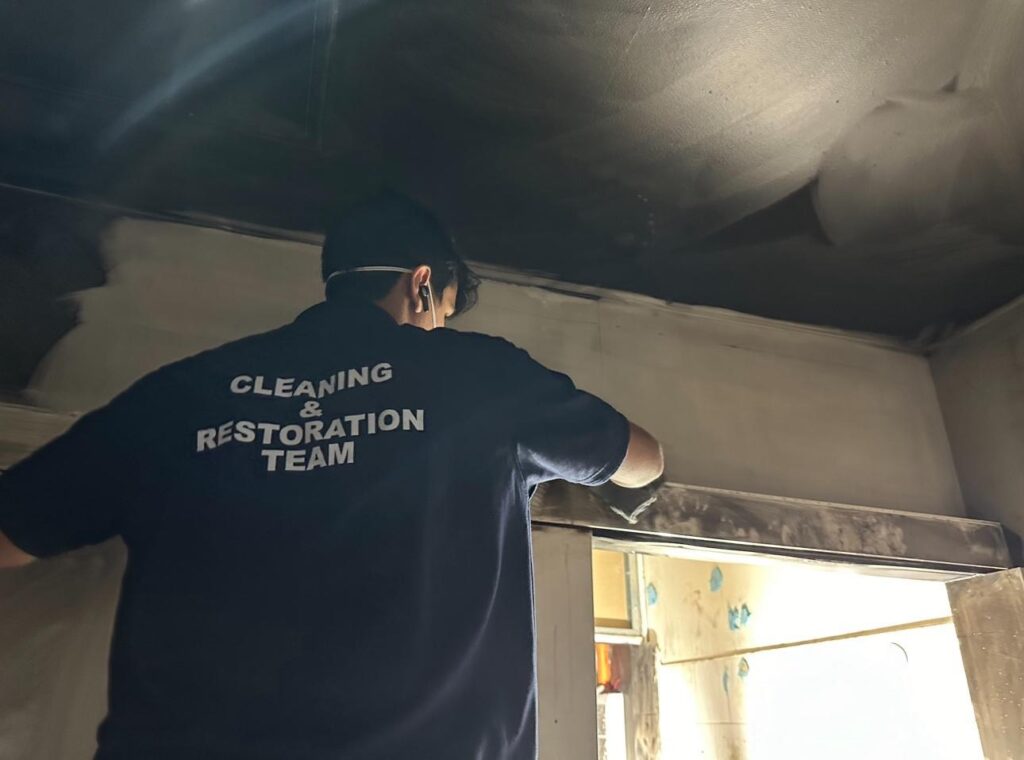
Stachybotrys Chartarum
Stachybotrys chartarum is a type of toxic black mould that can cause serious health problems. It grows where there is a lot of moisture and spreads quickly in damp areas like rising damp, water leaks, or water damage. This mould produces mycotoxins that may lead to severe health issues, especially for people with weak immune systems.
Types
The most common mould types found in Australia are:
- toxic black mould (Stachybotrys chartarum)
- green or white mould (Penicillium)
- brown mould (Alternaria)
- green mould (Aspergillus)
- white mould (Cladosporium)
Different types of mould can cause different health problems depending on how toxic they are and on a person’s health condition. There are more than 100,000 known species of mould, but only about 20 to 30 types are commonly found in Australian homes. For better understanding, these mould types are placed into low-risk and high-risk groups.
What Causes Black Mould
Black mould often appears in Australia because of moisture from water damage, leaks, rising damp, condensation, and poor ventilation. It is more common in warm and humid climates, especially in states like New South Wales, Victoria, and Queensland. The most well-known type, Stachybotrys chartarum, grows on materials such as plasterboard and wood when they stay wet for long periods of time.
Common Sources of Moisture in Australian Homes
- Water damage and leaks: Roof leaks, plumbing problems, and damage caused by floods or storms are major reasons mould develops.
- Condensation: Too much moisture in the air from heating systems or high humidity leads to condensation, often seen on cold surfaces like windows.
- Rising damp: Water rising from the ground through the foundations of a building, usually because of poor design or weak insulation, can create damp conditions.
- Poor ventilation: Bathrooms, kitchens, and other closed areas without enough airflow trap moisture and allow mould to grow.
- High humidity: Wet seasons, tropical storms, and humid weather across many regions in Australia create the perfect environment for mould.

Why Black Mould Grows in Australia
Warm and humid conditions in many parts of Australia make it easy for mould to grow. Sydney often experiences high humidity, especially in the summer months and after heavy rain, which creates the perfect environment for fungi like mould to spread.
Black mould grows by feeding on materials that are rich in cellulose. Common examples in Sydney homes include plasterboard, timber, paper, and even old cardboard boxes left in storage areas. Once moisture is present, these items become an easy food source for mould.
The way buildings are designed also plays an important role. Many older houses in Sydney have poor waterproofing, weak ventilation, and little to no underfloor insulation. These factors allow moisture to settle and create damp areas where mould can thrive. Even in modern apartments, issues such as leaky windows, plumbing faults, or poorly ventilated bathrooms can quickly lead to mould growth if they are not fixed.
Another challenge for Sydney residents is the coastal environment. Homes near the sea often face salt air and higher levels of moisture, which add to the risk of mould inside walls, ceilings, and furniture. This makes regular maintenance, timely repairs, and proper cleaning essential for preventing mould in the long run.
Is Black Mould Dangerous?
Mould reproduces by making very small particles called spores. These spores travel through the air and may cause health problems if they are breathed in by people who are sensitive or allergic to them.
Breathing in mould spores can cause a blocked or runny nose, irritation of the eyes and skin, and sometimes wheezing. For people who have asthma, exposure to mould spores may trigger an asthma attack.
In very rare cases, a person may develop a serious mould infection in the lungs. One example is a condition called hypersensitivity pneumonitis. This happens when the lungs become inflamed from breathing in large amounts of certain substances over a long period of time. The symptoms are similar to the flu and may include fever, cough, chills, and shortness of breath. If exposure continues for a long time, these symptoms may become worse.
If someone has hypersensitivity pneumonitis, they must see a doctor. A proper diagnosis will help manage the condition and reduce exposure to the substances that may be causing the problem.
It is also important to remember that most people do not experience health issues from mould. Everyone breathes in mould spores every day, and most people have no symptoms at all.
How Long Does It Take for Black Mould to Kill You?
Black mould does not kill people instantly, but long exposure to it can cause serious health problems. The time it takes for mould to harm someone depends on how much mould is present, how long a person is exposed, and their overall health.
For most healthy people, short contact with mould may cause mild symptoms like coughing, sneezing, or irritation of the skin and eyes. However, for people with asthma, allergies, or weak immune systems, breathing in mould spores over time can lead to severe infections or lung problems.
In very rare cases, long-term exposure in a poorly ventilated home may lead to life-threatening conditions. This is why it is important to book black mould removal services quickly and keep your home dry and clean to protect your health.
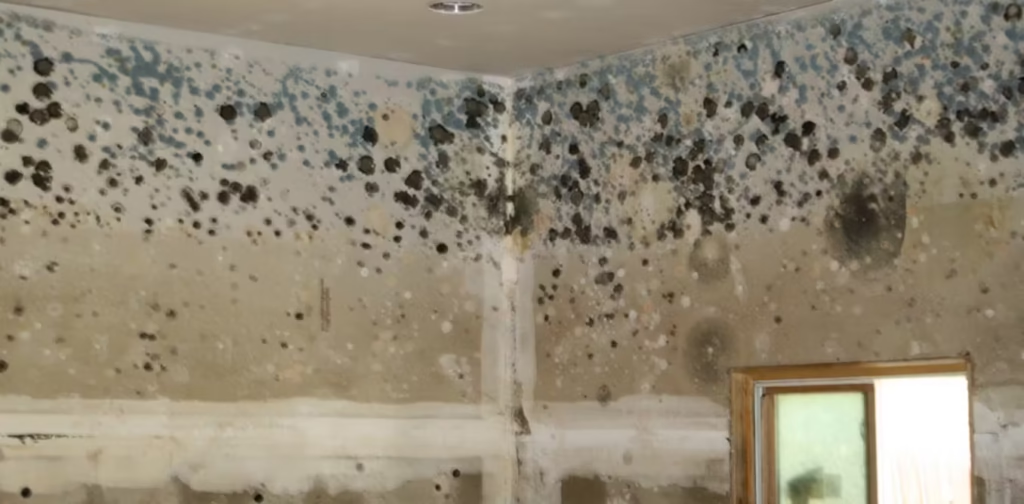
How Long Does It Take for Black Mould to Kill You?
Black mould does not kill people instantly, but long exposure to it can cause serious health problems. The time it takes for mould to harm someone depends on how much mould is present, how long a person is exposed, and their overall health.
For most healthy people, short contact with mould may cause mild symptoms like coughing, sneezing, or irritation of the skin and eyes. However, for people with asthma, allergies, or weak immune systems, breathing in mould spores over time can lead to severe infections or lung problems.
In very rare cases, long-term exposure in a poorly ventilated home may lead to life-threatening conditions. This is why it is important to book black mould removal services quickly and keep your home dry and clean to protect your health.
What are the signs of mould sickness?
The most frequent signs when you need black mould removal services are:
- Sneezing
- Coughing
- Nasal congestion
- Postnasal drip
- Red eyes
Black mould exposure can also worsen asthma symptoms, including:
- Wheezing
- Shortness of breath (dyspnea)
- Dry cough and chest tightness
What to Look For
Visible dark spots or clusters: Mould growth can appear as dark green to black patches on walls, ceilings, or other surfaces, often in damp, warm areas.
Water stains and discolouration: Look for water stains on walls and ceilings, which signal underlying moisture problems that foster mould growth.
Peeling paint or wallpaper: Water damage and moisture can cause paint to bubble or peel and wallpaper to lift, indicating a mould problem.
Warped or bulging walls: Bulging or warped wood or drywall can indicate that moisture is trapped and promoting mould growth.
Darker grout: Grout in bathrooms and kitchens may appear darker due to mould accumulating in humid environments.
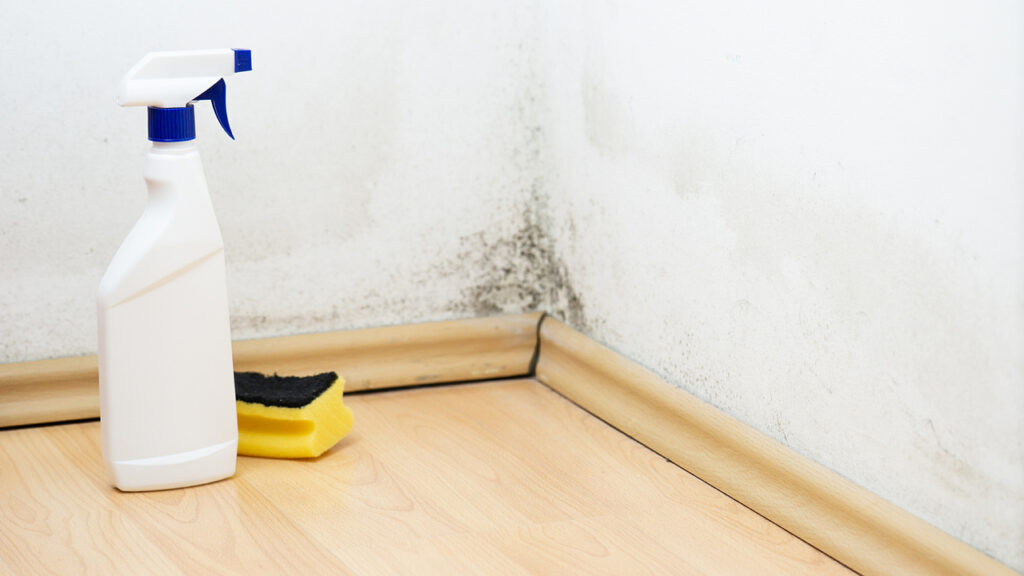
How to Remove Black Mould from Material Yourself
Throw away any mouldy items that cannot be cleaned. This includes things like cardboard boxes and mattresses.
Wash clothing, bedding, and soft toys in a washing machine using a hot cycle. If bedding or other fabrics have been mouldy for many weeks, they may not be able to be cleaned and should be discarded. Wash the clothes you wore during the cleaning separately from your regular laundry.
Soft furnishings that cannot fit in a washing machine may need professional cleaning. If this is not possible, they should be thrown away.
Clean all affected hard surfaces carefully. In many cases, normal household detergent or white vinegar will be enough. Use a microfibre cloth and rinse it often in a separate bucket of clean water. This will help stop the mould from spreading.
If you choose a commercial cleaner, always read the label. Follow the instructions on how much to use, where it can be applied, and the safety steps required. Never mix bleach with ammonia, acids, or other cleaners, as this can create dangerous fumes.
Apply the cleaner and allow time for it to work before wiping it away with a cloth or mop. Avoid soaking the surface with too much liquid. Dry the area well once the cleaning is done.
If you notice mould returning on large surfaces, call a professional mould remediation service.
To stop mould from coming back, it is important to dry the area fully. The easiest way to do this is by opening doors and windows to let fresh air flow through the home.
Safety Considerations with Mould Removal:
If you plan to remove mould, make sure the area is well ventilated. Wear protective clothing such as a shower cap, rubber gloves, safety glasses, overalls, closed shoes, and a P1 or P2 face mask that you can buy at a hardware store.
Pregnant women, children, and people with weak immune systems or long-term lung problems should not take part in mould removal.
If you are allergic or sensitive to mould, you may get a blocked nose, red or itchy eyes, wheezing, skin irritation, or trouble breathing. People with weak immune systems or lung diseases can also be at risk of infections. Anyone with heart or lung problems should speak with a doctor before using a P2 mask, as it may make breathing harder. If you have asthma and plan to clean mould, always keep your medication nearby. If you notice asthma symptoms, move to fresh air and follow your asthma action plan.
Do not use a dry brush to scrub mould, as this can spread spores into the air and make them easier to breathe in. If you need to vacuum the area, only use a vacuum with a HEPA filter. This type of filter traps tiny particles that normal vacuums release back into the air.
Before deciding to wear a P2 face mask, consider that:
Face masks can feel hot and uncomfortable. If the seal around the mouth and nose is poor, the mask will not work well. People with beards may find it difficult to get a proper seal.
Masks can also make breathing harder. Anyone with a heart condition or lung problem should ask a doctor for advice before using them.
If you have asthma and plan to clean mould, always keep your asthma medication with you. If you notice asthma symptoms, move to fresh air and follow your asthma action plan.
How to Remove Black Mould from Ceiling:
Ceilings are often affected by black mould. Warm air collects near the ceiling and creates the right conditions for mould to grow, especially in bathrooms where the air is damp. Many ceilings do not have enough ventilation, which makes the problem worse.
Mould can also appear on ceilings because of leaking roofs or plumbing. Storms may damage the roof and allow water to soak into the ceiling. Black mould on the ceiling is sometimes the first warning sign of a serious issue, such as a roof or plumbing leak.
It is important to find the cause of the ceiling mould quickly. If left untreated, it can damage ceiling panels and even the structure of the roof. Bathrooms are a common place for ceiling mould because steam builds up and ventilation is often poor. These conditions allow mould to spread and release harmful particles into the air.
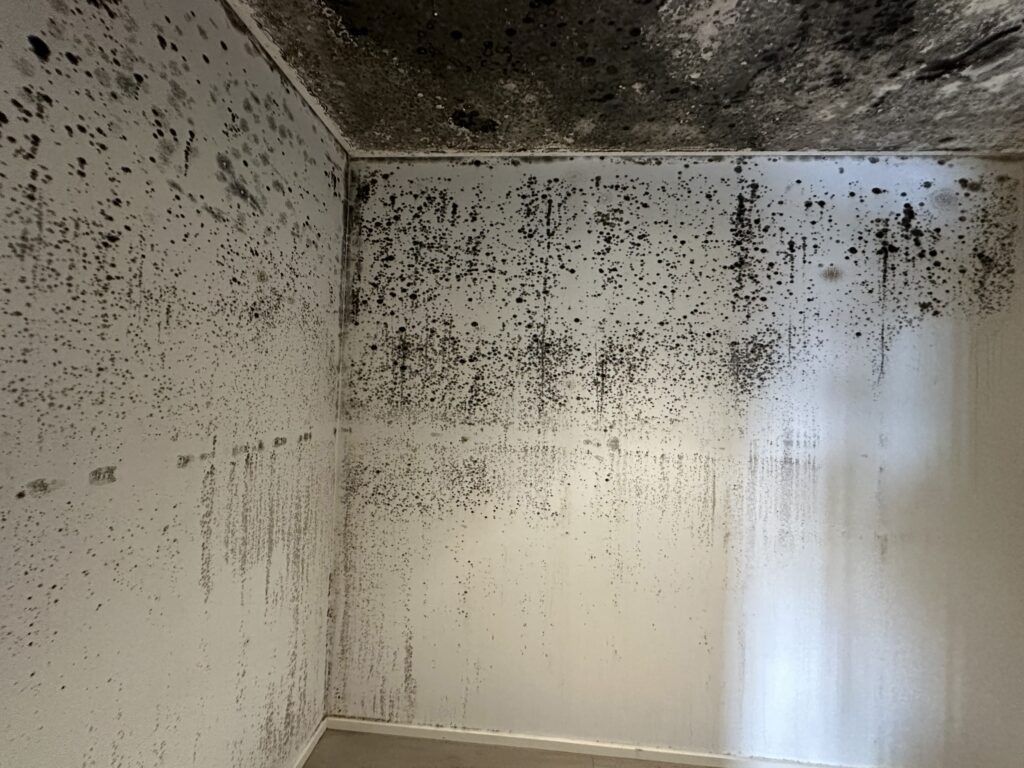
How to Remove Black Mould from Walls
Black mould loves walls because:
- Furniture, curtains, and other items placed close to walls can block airflow and create conditions for mould to grow.
- Plumbing leaks hidden inside walls can also encourage mould to develop.
- Insulation that has become damp often stays wet for a long time and provides an ideal place for mould to thrive.
- Leaks around window and door frames may also cause mould to appear inside wall panels.
Walls are one of the most common places where mould grows, especially in corners or areas with little airflow. Furniture placed too close to walls can also trap moisture and create conditions for mould to spread. When mould is left to grow, both people and pets in the home may start to show symptoms linked to exposure to its toxins.
It is important to check hidden spots such as behind curtains, wardrobes, and wall hangings for signs of black mould. Finding mould around window frames, door frames, or near the ceiling may also point to structural issues that allow moisture to enter the walls.
How to Remove Mould from Windows:
Doors and windows are a potential easy habitat for black mould because:
- Windows that are not installed properly can let water enter the wall cavity
- Condensation often forms on glass and then drips onto wooden window frames, especially if the timber is not treated.
- When flashings are not fitted correctly, wind-driven rain can seep into wall cavities.
- Curtains and drapes may absorb this condensation and create damp conditions that encourage mould growth.
Mould often appears on windows behind curtains and in the corners of window frames. These are usually the first places where black mould is noticed.
Poor ventilation and high levels of condensation are the most common reasons. Sometimes, however, the mould may point to a more serious problem that needs fixing before the cleaning can be effective.
Removing the cause is important because it reduces the chance of mould returning and helps limit exposure to black mould, which may affect health.
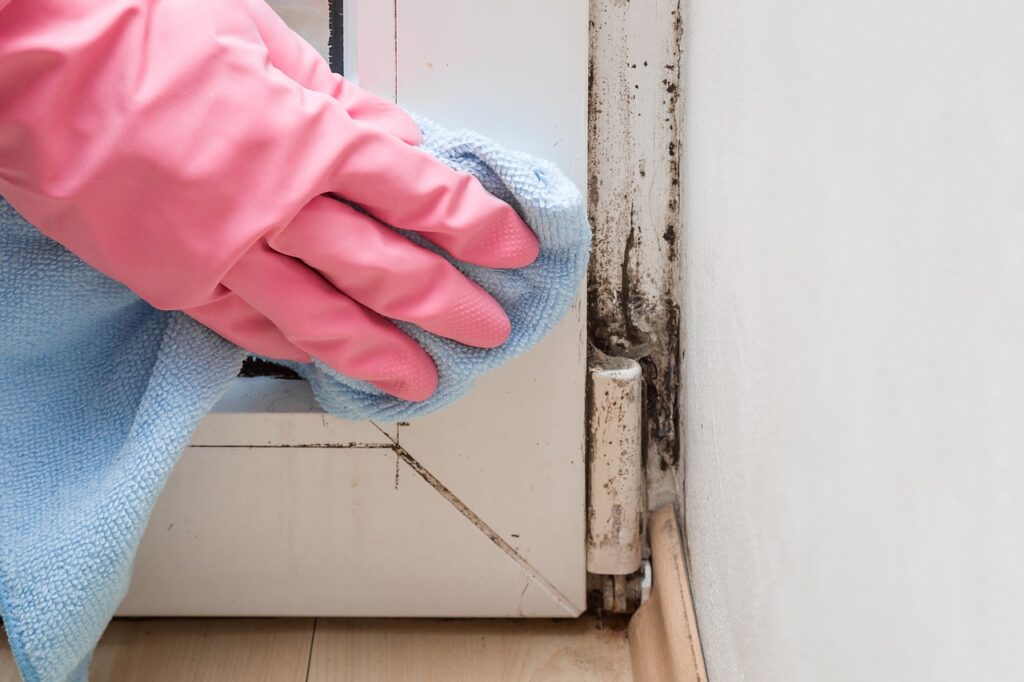
When to Call in the Experts?
The sooner the mould is removed, the less chance it has to become a long-term problem. Small patches of less than one square metre can sometimes be cleaned at home. The issue is that self-cleaning can easily make the problem worse if it is not done correctly.
Mould removal needs more than surface cleaning. What you see is only a small part of the problem. The real cause is often hidden, and fixing it should be the first step.
Calling a professional mould removal service early can help protect your property from serious damage. Skilled technicians use specialised tools and methods to find, treat, and stop mould growth. Whether the mould is in a bathroom, bedroom, or workplace, expert help ensures the job is done properly and safely.
Black Mould Removal Services & What to Expect
A black mould removal service usually begins with an inspection to identify the source of moisture and the amount of mould present. After this, the team contains the affected area and cleans the surfaces to remove the mould and reduce airborne spores.
Special equipment such as moisture meters, air filters, and purifiers may be used during the process. This ensures not only the removal of visible mould but also the purification of indoor air. Antimicrobial treatments are often applied to stop mould from coming back.
The service also includes advice on how to prevent mould in the future by fixing moisture problems in the home. Many professional services may also provide a warranty to give peace of mind that the work is effective. Candid Cleaners offers complete mould remediation backed by experience, advanced tools, and reliable service guarantees.
Here's a breakdown of what to expect from a black mould removal service:
1. Inspection & Assessment
- Professional inspection means trained technicians visit the site to check the areas where mould is growing and to find the source of the problem.
- Moisture detection is done using tools such as moisture meters or infrared cameras to measure humidity and locate where the water is coming from.
- The inspection also shows how serious the problem is. This includes visible mould as well as any hidden growth behind walls or under floors.
2. Treatment Plan & Preparation
- After the inspection, a clear plan is made to remove the mould and fix the cause of the moisture.
- The affected area is then sealed off to stop mould spores from spreading to other parts of the property.
- Air purifiers may be used to clean the air and capture spores, which makes the space safer during the treatment.
3. Mould Removal & Remediation
- Professionals clean the affected surfaces with safe and effective cleaning products to remove visible mould and stains.
- Special treatments are then applied to kill any remaining mould and to create a barrier that helps stop it from growing again.
- In some cases, damaged materials such as carpets or wallpaper that have absorbed mould may need to be removed and replaced.
4. Post-Treatment & Prevention
- The final step includes cleaning and drying all treated areas carefully so that no mould or residue is left behind.
- A detailed report is then given to explain the work that was carried out and the results of the treatment.
- Advice is also provided on how to prevent mould from returning, such as fixing leaks or improving ventilation in the home.
- Some professional services may also give a warranty to ensure that their mould removal work is effective.
How to Stop Black Mould from Coming Back
There are multiple things you can do to mitigate mould growth:
- Keep windows and doors open to bring in fresh air and lower humidity inside the home.
- Let sunlight in by opening blinds and curtains during the day.
- Use an exhaust fan or open a window in the bathroom, kitchen, and laundry to remove steam.
- Wipe tiles after use to remove soap scum that can feed mould.
- Clean away moisture from windows and walls to keep indoor spaces dry.
- Make sure clothes and shoes are fully dry before putting them away.
- Air out cupboards and wardrobes often to prevent dampness.
- Place moisture absorbers in basements, wardrobes, and closed rooms to control damp air.
Conclusion
Mould may start small, but it can quickly grow into a serious problem if left untreated. Knowing the early signs, such as musty smells, discoloured walls and damp patches, can help you take action before it spreads. It is important to understand that mould is not only unpleasant to look at but also dangerous to your health and damaging to your home.
Professional mould removal ensures that all traces are cleaned safely and effectively, preventing them from returning. Regular cleaning, proper ventilation and moisture control can also help keep your home mould-free.
If you are dealing with mould issues, do not wait for it to get worse. Contact trusted experts like Candid Cleaners for reliable mould remediation services in Sydney. Their professional team can help restore a clean, safe and healthy environment in your home.
